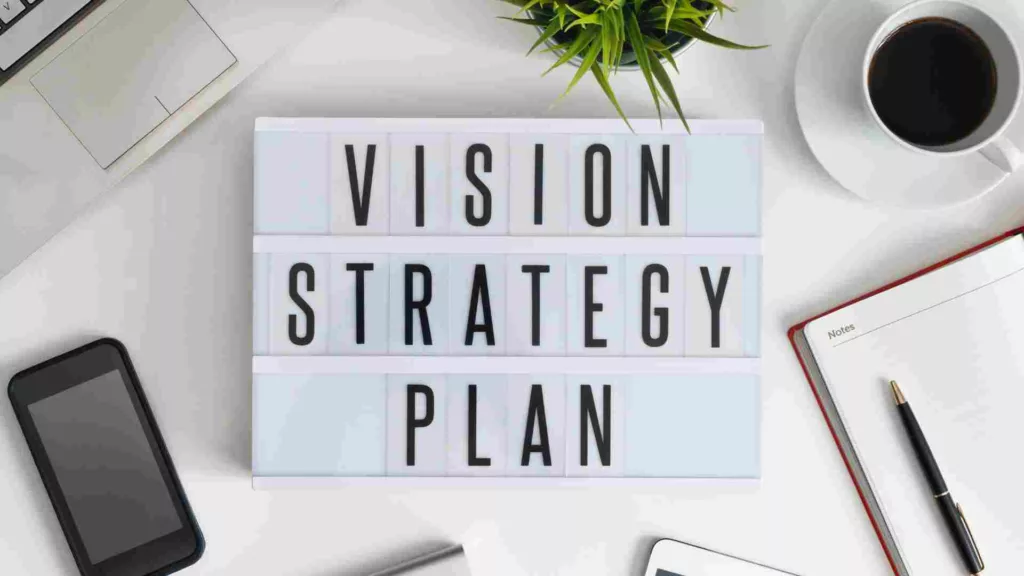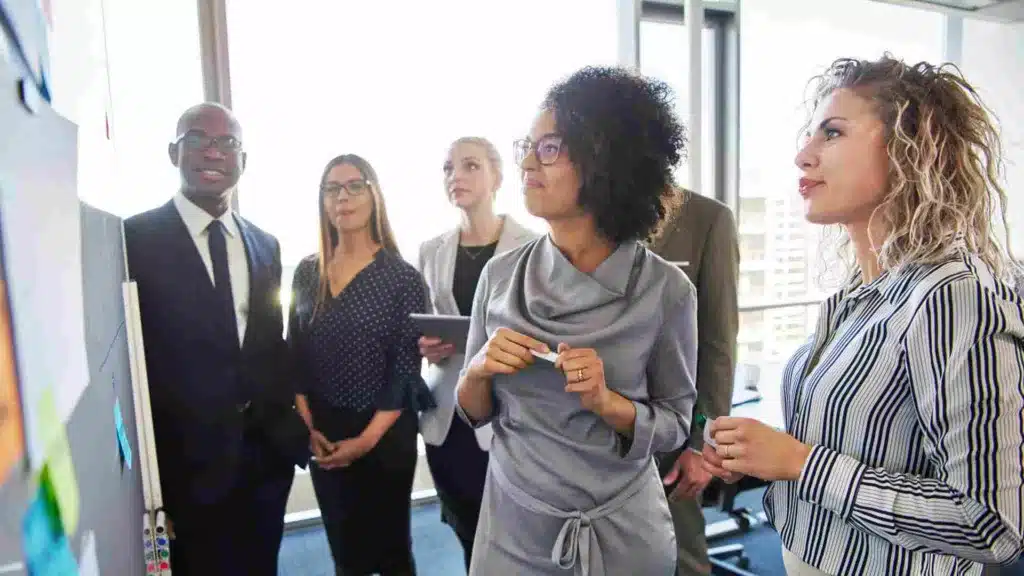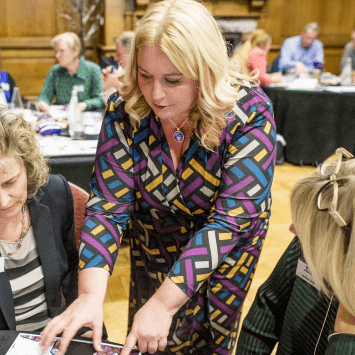Posted in Blog, Entrepreneurship, Facilitation, Intrapreneurship by Jo North
A strategic visioning workshop benefits every organization or significant project, whether at the beginning of a new phase or to adjust as your internal and external worlds shift. It’s one of the most frequent and important types of workshop that we facilitate for our clients.
In this article, I share why every organization or project needs a strategic vision, along with an agenda and tips for how to facilitate a successful strategic visioning workshop.

What is a Strategic Vision?
A strategic vision is a shared vision and long-term goal that drives every decision in the organization or project.
When charting the course for an organization or a pivotal project involving numerous stakeholders, having a clear direction is essential. This direction, often referred to as the “North Star,” embodies the organization’s or project’s strategic vision.
A great strategic vision stems from a well-defined problem statement, pinpointing where the opportunities and challenges lie, and setting the direction for overcoming them.
A strategic visioning workshop helps define that guiding North Star for your organization, and establishes the vision, goals, and targets essential for your strategic development plan.
Whether you’re steering the entire organization, bringing together a community to make decisions together, or working on a crucial project, understanding and defining your shared vision is the key to future success.
Examples of Strategic Visioning Workshops
Here are just a few examples of the kinds of strategic visioning workshops that my team and I have run for our clients:
- Corporate visioning, setting a medium or long term vision for the business.
- Scaleup businesses looking to breakthrough to their next level of growth. This includes getting investment ready and developing a communicable vision that connects with funders and other key stakeholders.
- Startups wanting to achieve positive impact through their products and services.
- Social enterprises and charities wanting to extend and deepen their impact.
- Brand, product and service specific visions, for companies with a portfolio of customer propositions.
- Academic researchers leading collaborative research projects with industry and communities to optimize impact.
- Communities coming together on a shared project or decision, such as how best to spend funding, or increase biodiversity in their location.
- Bid teams wanting to create a compelling vision for a significant client proposal, contract or tender.
Why is Strategic Visioning Important?
Crafting a clear vision for your project’s or organization’s future direction requires some thought. It demands creativity, clear focus, and courage
Setting intentional bold, meaningful, and enduring goals is your gateway to superior performance and sustained outcomes.
At its core, strategic visioning is about pinpointing the common ground. It’s the intersection where your organization’s mission, vision and values align with the aspirations of your target customers, valued employees, and key stakeholders. This alignment fosters a shared understanding and a common goal, propelling everyone forward with a unified purpose.
Start with “Why?”
Simon Sinek famously emphasized the importance of understanding your “why.” Before diving into the “what” or “how,” you must “start with why.” It’s this fundamental ‘why’ that shapes a compelling and clear vision, guiding actions and decisions in the direction of collective success.
The strategic vision serves as a catalyst, shaping the plan’s aspirations. It helps to turn opportunities into tangible objectives, breaking down challenges into specific goals and targets.
Who Should Attend Your Strategic Visioning Workshop?
We work with our clients to make sure that the right mix of people participate in the event.
Executive Teams
As the primary decision-makers, executive teams from both the organization and the project need to be present. Their combined insights will shape the broader goals, ensuring alignment with the strategic direction.
Team Members
From the organizational to the project level, these individuals play pivotal roles in executing the envisioned strategies. They bring hands-on experience and offer a granular perspective, ensuring the vision is rooted in reality.
Staff Members
Beyond the decision-makers, staff from both the organization and the project can provide unique insights. With their intimate understanding of daily operations, they can pinpoint areas for improvement, innovation, and efficiency.
Project-specific Attendees
For projects, it’s essential to include representatives who understand its unique challenges and nuances. Whether they are engineers for a tech initiative or field managers for a grassroots project, their specialized knowledge will enrich the strategic visioning process.
Key Stakeholders
Engaging both organizational and project stakeholders is vital. These may be investors, clients, or any major entities deeply vested in the initiative’s success. Their perspectives help in fine-tuning the vision to cater to external expectations and market dynamics.
It’s sometimes advisable to have an internal strategic visioning workshop first, before you invite others for their perspectives. This depends on your organization’s specific context.

Sustainability in Visioning
Building sustainability into your strategic vision is a necessity.
Integrating sustainable practices and strategies into your visioning workshop will ensure your organization or project’s longevity and resonate better with the growing eco-conscious segments of your stakeholders.
Balancing Profit and Planet
It’s essential to find a sweet spot where the organization or project is not just profitable, but also environmentally responsible. This balance can influence business decisions and project implementations, ensuring a win-win for both the company and the environment.
Stakeholder Expectations on Sustainability
Now more than ever, stakeholders, be they consumers, investors, or employees, are leaning towards eco-friendly innovations. By addressing these expectations in the workshop, you ensure that your strategic vision aligns with the demands and values of those you serve.
Sustainable Innovations
Exploring innovations that are sustainable can open doors to new opportunities and markets. Whether it’s a product, service, or methodology, sustainable innovations can set you apart from competitors and future-proof your initiatives.
Strategic Visioning Workshop Preparation
Preparing adequately for your strategic visioning workshop can mean the difference between a successful event that yields actionable insights and one that falls short. Proper groundwork ensures that all attendees are aligned and have the necessary context to contribute meaningfully to the discussions.
Engaging Executives and Stakeholders Early
One of the first steps in workshop preparation should be to interview key executives and stakeholders. Their insights, based on their unique vantage points within the organization or the project, can provide crucial context and direction for the workshop. By engaging them early, you also ensure that they have a sense of ownership and commitment to the workshop’s outcomes.
Setting the Agenda and Pre-work
To ensure all attendees come prepared and aligned, it’s beneficial to share the workshop agenda in advance. Additionally, providing them with specific pre-work can set the stage for deeper and more informed discussions. Here are some areas you might consider for pre-work:
Understand the Landscape
Ask participants to delve into the industry or sector your organization operates within. They should explore recent trends, identify gaps, celebrate successes, and pinpoint opportunities. This will give them a broader context of the external environment.
Customer and Stakeholder Insights
Encourage participants to engage with or research customers and other stakeholders. They should aim to understand changing needs, aspirations, and any emerging trends that could impact the organization or project.
SWOT Analysis
Before the workshop, attendees should familiarize themselves with the organization’s Strengths, Weaknesses, Opportunities, and Threats (SWOT). This can provide a holistic view of where the organization stands and where it could potentially go.
With these preparation steps in place, you’ll make sure that everyone gets maximum value from the time and energy you invest in your strategic visioning workshop.

Agenda for Your Strategic Visioning Workshop
Introducing the Purpose of the Workshop
When organizing a Strategic Visioning Workshop, setting a clear, structured agenda is crucial. Not only does it provide direction for the participants, but it also ensures that all vital topics are covered in depth.
Make sure that everyone is super clear on the purpose of the workshop, and what you are aiming to achieve together.
Key Sessions
1. Defining Opportunities and Challenges: The First Step
Begin the workshop by diving into opportunities and challenges for the future. A major component of this segment should be verifying if your target customers are still aligned with your current offerings. Have their needs evolved? Is there a pivot needed in your approach or services to remain relevant? Sharing the pre-work done in this area can provide valuable insights, setting the stage for informed discussions.
2. Current State Analysis
Understanding where you stand today is vital. Dive deep into the organization’s or project’s current performance metrics, strengths, weaknesses, and unique selling points.
3. Stakeholder Perspectives
Consider the expectations, challenges, and aspirations of all stakeholders. Their feedback and insights can greatly influence the strategic roadmap.
Consider using some of the stakeholder mapping tools from my article here for this pre-work.
4. Competitive Landscape
Understanding your competitors and the broader market is crucial. Identify potential challenges, market trends, and areas where you can carve out a niche.
Here are some tools and activities you can use for your competitor analysis.
5. Envisioning the Future Landscape
While you’re planning your strategy execution, it’s essential to keep an eye on the future. This includes understanding potential challenges and opportunities on the horizon, identifying where competitors might be headed, and ensuring your organization remains agile and adaptive.
6. Future State Visualization
Once the current state is clear, it’s time to envision the future. What does success look like? How has the landscape changed, and where does your organization or project fit within it?
7. Reimagine Your Purpose
After establishing the external environment, the next step in the strategic visioning process is to reimagine the organization’s purpose for the upcoming years. What drives your organization forward? What do you stand for? Crafting a common vision statement during this phase ensures everyone is aligned with the overarching mission.
8. Impact Assessment
Now that the purpose is set, it’s time to delve into its implications. How will the newly imagined purpose affect target customers? What changes might key stakeholders anticipate? And critically, how will employees, the human core of the organization, be impacted by this shift? Group exercises can be particularly effective here, allowing participants to brainstorm, discuss, and collaborate on potential scenarios.
9. Bridging the Gap
Brainstorm actions that will bridge the gap between your current and target future states. Prioritize your ideas to get the best return on resources, time, and effort. Get clarity on what needs to happen after the workshop to make sure that progress continues.
By delving into these topics during your strategic visioning workshop, you set the stage for a comprehensive plan that caters to all aspects of your organization or project, ensuring a robust and future-ready strategy.
Top Tips for Facilitating a Strategic Visioning Workshop
Facilitation Best Practices
While every workshop is unique, there are universal facilitation best practices that can enhance its effectiveness. Clear communication, active listening, and managing group dynamics are all integral to achieving the workshop’s core objective. Remember, the goal is not just to generate ideas but to ensure they align and contribute to the broader strategic vision. Have a look at my guide to being a great facilitator here.
Encourage Creative Thinking
One of the primary goals of any workshop is to encourage out-of-the-box ideas. To do this, it’s crucial to create an environment that fosters creative thinking. This means ensuring participants feel comfortable sharing even the most unconventional thoughts without fear of judgment. The richness of different visions can be the catalyst for breakthroughs in strategy.
The Power of Small Group Working
Instead of always working with the entire group, consider breaking participants into smaller teams for specific tasks. Small group working can help introverted participants voice their opinions and allow for more in-depth discussions on particular topics.
If you’re working online, here are some tips on how to use breakout rooms in Microsoft Teams and in Zoom.
Using Graphic Guides
People often process visual information faster than written or spoken words. Introducing graphic guides or visual aids can help participants grasp complex concepts quickly. Whether it’s a flowchart, infographic, or even a mind map, the right tool can enhance understanding and engagement.
Perfecting the Workshop Setting
The physical or virtual environment plays a significant role in the success of the workshop. Ensure the workshop setting is conducive to focused work and open dialogue. This could mean selecting a quiet room with adequate seating and lighting for physical meetings or ensuring a stable internet connection and user-friendly platform for virtual and hybrid sessions.
Welcoming Different Visions
While the aim is to arrive at a cohesive strategic vision, it’s essential to remember that different perspectives can enrich the final outcome. Rather than seeing divergent views as challenges, view them as opportunities to refine and bolster the overarching strategy.
By integrating these tips into your approach, you’ll be well on your way to facilitating a successful Strategic Visioning Workshop that yields actionable and forward-thinking results.
How to Progress Your Strategic Visioning Workshop
After laying the foundation and facilitating fruitful discussions, the next challenge lies in ensuring the outcomes of your Strategic Visioning Workshop are actionable and drive results. Progressing the results of the workshop involves turning abstract ideas into concrete steps that bring your powerful vision to life.
From Vision to Action
Having a powerful vision is crucial, but the real challenge lies in turning that vision into reality. It’s essential to convert the insights and strategies discussed during the workshop into tangible action plans. These plans serve as the blueprint for the subsequent stages, ensuring that everyone knows their role in realizing the vision.
Project Management at the Forefront
Once the action plans are drafted, the principles of project management become indispensable. Leveraging project management tools and methodologies ensures that plans are organized, on track, and align with the goals set out during the workshop.
The Role of the Team Leader
In progressing the outcomes of the workshop, the role of the team leader is paramount. The team leader is responsible for ensuring that the final decisions made during the workshop become actionable steps. They also play a crucial role in monitoring progress, providing feedback, and ensuring the entire project team remains aligned with the overarching vision.
Assembling the Project Team
Behind every successful vision is a dedicated project team working tirelessly to bring it to fruition. This team is composed of individuals from various disciplines and expertise. They are the ones who take the strategies and decisions from the workshop and put them into practice, ensuring that every step aligns with the established goals.
By focusing on these elements, you ensure that the insights and strategies derived from your strategic visioning workshop are not just theoretical but are transformed into real-world results that move your organization or project forward.
Next Steps for Your Strategic Visioning Workshop
After understanding the importance and intricacies of a strategic visioning workshop, the next step is crucial: deciding who will guide you through this transformative process. An external facilitator can provide a fresh perspective, unbiased insights, and the expertise required to navigate the complexities of crafting a strategic vision.
Why Work with an External Facilitator?
Why should you consider working with an external facilitator?
An external facilitator adds a layer of professionalism and objectivity to your event. The role of such a facilitator is to ensure that the discussions remain focussed, productive, and aligned with the workshop’s objectives. They bring a wealth of experience from different industries and can offer solutions and strategies you might not have considered.
For strategic visioning, my team and I have a track record of success and a deep understanding of the intricacies of business strategy workshops and strategic innovation. We can guide your organization through this transformative journey.
If you’re considering embarking on a Strategic Visioning Workshop, please do get in touch with me here for a no-obligation chat. I’d love to hear from you.


